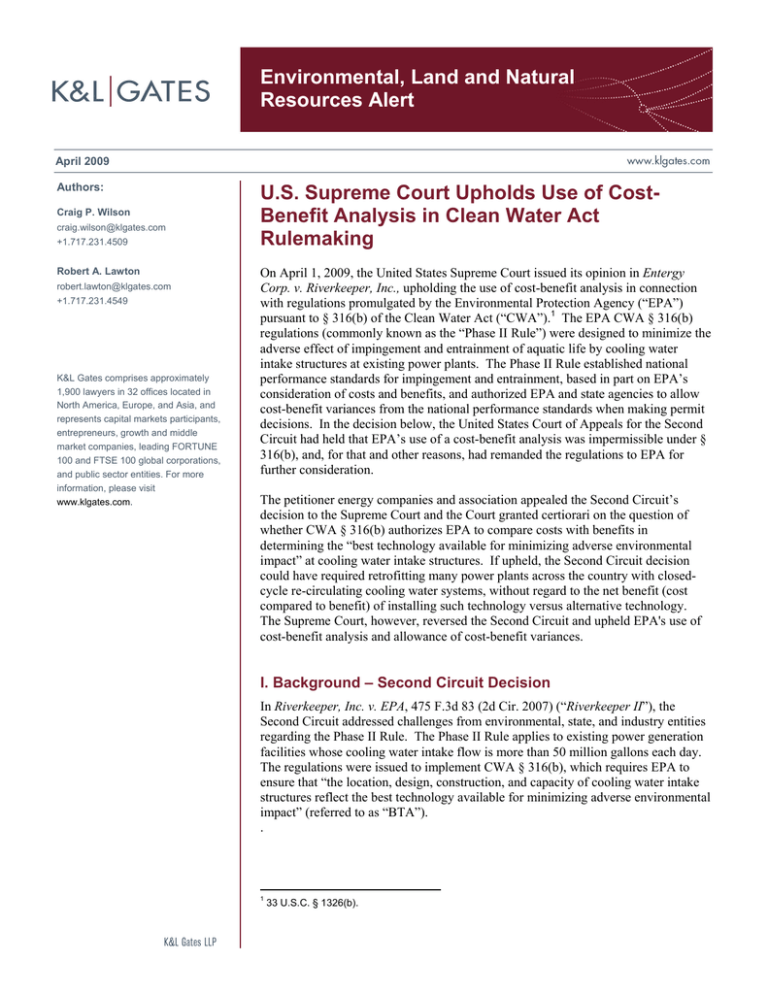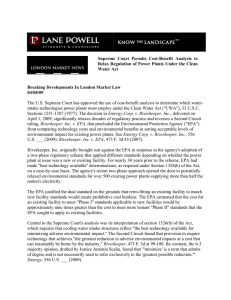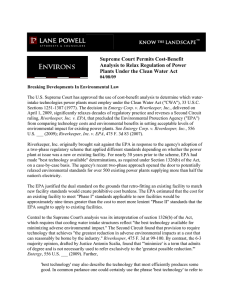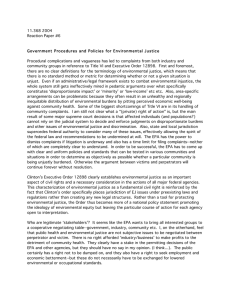Environmental, Land and Natural Resources Alert Benefit Analysis in Clean Water Act
advertisement

Environmental, Land and Natural Resources Alert April 2009 Authors: Craig P. Wilson craig.wilson@klgates.com +1.717.231.4509 Robert A. Lawton robert.lawton@klgates.com +1.717.231.4549 K&L Gates comprises approximately 1,900 lawyers in 32 offices located in North America, Europe, and Asia, and represents capital markets participants, entrepreneurs, growth and middle market companies, leading FORTUNE 100 and FTSE 100 global corporations, and public sector entities. For more information, please visit www.klgates.com. U.S. Supreme Court Upholds Use of CostBenefit Analysis in Clean Water Act Rulemaking On April 1, 2009, the United States Supreme Court issued its opinion in Entergy Corp. v. Riverkeeper, Inc., upholding the use of cost-benefit analysis in connection with regulations promulgated by the Environmental Protection Agency (“EPA”) pursuant to § 316(b) of the Clean Water Act (“CWA”).1 The EPA CWA § 316(b) regulations (commonly known as the “Phase II Rule”) were designed to minimize the adverse effect of impingement and entrainment of aquatic life by cooling water intake structures at existing power plants. The Phase II Rule established national performance standards for impingement and entrainment, based in part on EPA’s consideration of costs and benefits, and authorized EPA and state agencies to allow cost-benefit variances from the national performance standards when making permit decisions. In the decision below, the United States Court of Appeals for the Second Circuit had held that EPA’s use of a cost-benefit analysis was impermissible under § 316(b), and, for that and other reasons, had remanded the regulations to EPA for further consideration. The petitioner energy companies and association appealed the Second Circuit’s decision to the Supreme Court and the Court granted certiorari on the question of whether CWA § 316(b) authorizes EPA to compare costs with benefits in determining the “best technology available for minimizing adverse environmental impact” at cooling water intake structures. If upheld, the Second Circuit decision could have required retrofitting many power plants across the country with closedcycle re-circulating cooling water systems, without regard to the net benefit (cost compared to benefit) of installing such technology versus alternative technology. The Supreme Court, however, reversed the Second Circuit and upheld EPA's use of cost-benefit analysis and allowance of cost-benefit variances. I. Background – Second Circuit Decision In Riverkeeper, Inc. v. EPA, 475 F.3d 83 (2d Cir. 2007) (“Riverkeeper II”), the Second Circuit addressed challenges from environmental, state, and industry entities regarding the Phase II Rule. The Phase II Rule applies to existing power generation facilities whose cooling water intake flow is more than 50 million gallons each day. The regulations were issued to implement CWA § 316(b), which requires EPA to ensure that “the location, design, construction, and capacity of cooling water intake structures reflect the best technology available for minimizing adverse environmental impact” (referred to as “BTA”). . 1 33 U.S.C. § 1326(b). Environmental, Land and Natural Resources Alert The Phase II Rule permitted existing power facilities to satisfy BTA through the selection and implementation of one of five compliance alternatives. Compliance alternatives included the option to demonstrate that a facility’s existing design and construction technologies meet specified national performance standards. The regulations also authorized issuance of sitespecific variances, as one of the compliance alternatives, upon demonstration that the costs of compliance are “significantly greater than” the costs considered by EPA in setting the national performance standards or that the costs of compliance would be “significantly greater than the benefits” of compliance with the performance standards. The Second Circuit determined that EPA may have exceeded its authority by rejecting closedcycle cooling generally as a national requirement and establishing instead the national performance standards on the basis of a cost-benefit analysis. Because the basis for EPA’s decision was not clear, the court remanded the matter to EPA for clarification of whether establishment of the national performance standards was based on a cost-benefit analysis or merely a costeffectiveness analysis. The Second Circuit also determined that a process of comparing costs and benefits of various alternatives, and selecting the one with the best “net benefits,” is not authorized by CWA § 316(b). II. U.S. Supreme Court Decision In a 6-3 decision written by Justice Scalia, the Supreme Court reversed the Second Circuit and held that EPA permissibly relied on a cost-benefit analysis in setting the national performance standards and in providing for cost-benefit variances from those standards as part of the Phase II Rule. Chief Justice Roberts and Justices Kennedy, Thomas, and Alito joined in the majority opinion. Justice Breyer wrote separately, agreeing with the majority that the CWA allows EPA to compare cost and benefit, but saying that he would have sent the matter back to EPA to clarify its standards. Justice Stevens filed a dissenting opinion, in which Justices Souter and Ginsburg joined. a. Majority The Court reviewed whether EPA’s decision to set Phase II national performance standards and to provide site-specific cost-benefit variances was a reasonable interpretation of the CWA. A reasonable interpretation, as recognized by the Court, is “not necessarily the only possible interpretation, nor even the interpretation deemed most reasonable.”2 The interpretation only must be reasonable. In this case, the issue involved EPA’s interpretation of the statutory language in CWA § 316(b) requiring use of “the best technology available for minimizing adverse environmental impact.” The Second Circuit had interpreted this language to mean “the technology that achieves the greatest reduction in adverse environmental impacts at a cost that can reasonably be borne by the industry.”3 The Supreme Court acknowledged that this was a plausible interpretation; however, the Court noted that a similarly plausible interpretation is that “best technology” could “describe the technology that most efficiently produces some good.”4 Thus, “best technology,” in the Court’s opinion, could “refer to that which produces a good at the lowest per-unit cost, even if it produces a lesser quantity of that good than other available technologies.”5 The Court also reviewed parallel provisions of the CWA that have language similar to the provision at issue here, such as “best practicable control technology,” “best available technology economically achievable,” “best conventional pollutant technology,” and “best available demonstrated control technology.” Some of these provisions, and associated statutory tests, expressly allow cost-benefit analysis, while others (respondent environmental groups argued) preclude such analysis. The BTA provision in § 316(b) is silent on the point. The Court opined that this omission “can reasonably be interpreted to suggest that EPA is accorded greater discretion in determining the precise content.”6 2 Entergy Corp. v. Riverkeeper, Inc., 556 U.S. __, __ (2009) (slip op., at 7) (opinion of the Court). 3 Riverkeeper II, 475 F.3d at 99-100. 4 Entergy, 556 U.S. at __ (slip op., at 8) (opinion of the Court). 5 Id. 6 Id., at __ (slip op., at 11). April 2009 2 Environmental, Land and Natural Resources Alert The Court disagreed with respondents’ argument that because Congress did not provide expressly for use of cost-benefit analysis in § 316(b), as it did elsewhere, Congress intended to forbid it. The Court responded that drawing such inference “from the silence [of § 316(b)] is, in any event, implausible, as [§ 316(b)] is silent not only with respect to cost-benefit analysis but with respect to all potentially relevant factors. If silence here implies prohibition, then the EPA could not consider any factors in implementing [§ 316(b)] – an obvious logical impossibility.”7 The Court, therefore, found it reasonable to conclude that CWA § 316(b)’s silence conveys “a refusal to tie the agency’s hands as to whether cost-benefit analysis should be used, and if so to what degree.”8 The Court also compared the Phase II Rule with EPA’s existing practices for the past 30 years. The Court noted that as early as 1977, EPA determined that it was not reasonable to “interpret Section 316(b) as requiring use of technology whose cost is wholly disproportionate to the environmental benefit to be gained.”9 The Court recognized that the “wholly disproportionate” standard may be different from Phase II’s “significantly greater than” standard; however, there is nothing in the statute that indicates one interpretation is permissible and the other is not. After considering the text of § 316(b), the parallel provisions, and EPA historical practices, the Court held that EPA’s interpretation of CWA § 316(b) was reasonable. Therefore, the Court concluded that it was permissible for EPA to rely on cost-benefit analysis in setting the national performance standards and in providing for costbenefit variances from those standards. The Court, however, did not express a view on the remaining bases for the Second Circuit’s remand.10 Accordingly, the Second Circuit’s remand of other parts of the Phase II Rule, e.g., use of restoration measures to achieve compliance, is not impacted by the decision. 7 Id., at __ (slip op., at 12). Id. 9 Id., at __ (slip op., at 14). 10 Id., at __ (slip op., at 16), stating: “We of course express no view on the remaining bases for the Second Circuit’s decision which did not depend on the permissibility of costbenefit analysis.” b. Concurrence In his concurrence, Justice Breyer agreed with the majority that the CWA gives EPA the authority to compare costs and benefits. Justice Breyer dissented from the majority because he was not convinced that EPA had successfully explained the basis for its change from the “wholly disproportionate” to the “significantly greater than” cost-benefit standard. Justice Breyer recognized that “significantly greater” differs from “the words the EPA has traditionally used to describe its standard, namely ‘wholly disproportionate.’”11 He expressed the opinion that EPA never adequately explained why this change occurred or even if the change represents a new and different test (or no change at all). Accordingly, Justice Breyer concluded that, like the majority, he would remand the case to the Second Circuit; however, unlike the majority, Justice Breyer would have preferred the Second Circuit to remand the cases to the EPA to “either apply its traditional ‘wholly disproportionate’ standard or provide an adequately reasoned explanation for the change.”12 c. Dissent Justice Stevens wrote a dissent joined by Justices Souter and Ginsburg. The dissent disagreed with the majority’s conclusion that EPA’s interpretation of CWA § 316(b) was reasonable and that EPA could permissibly consider cost-benefit analysis. The dissent diverged from the majority particularly as to whether silence in the pertinent statutory provision constitutes a prohibition. Justice Stevens wrote that the section of the CWA in question “neither expressly nor implicitly authorizes the EPA to use cost-benefit analysis when setting regulatory standards; fairly read, it prohibits such use.”13 He reached this conclusion based, in part, upon his determination that Congress should have expressed a clear intent if it wished the agency to use cost-benefit in crafting regulations. He wrote that “this Court has recognized that when Congress has intended that an agency engage in cost-benefit analysis, it has clearly indicated such intent on the face of the statute.”14 Thus, Justice Stevens felt that the Court should not treat CWA § 316(b)’s silence as 8 11 Id., at __ (slip op., at 7-8) (BREYER, J., concurring). Id., at __ (slip op., at 8). 13 Id., at __ (slip op., at 2) (STEVENS, J., dissenting). 14 Id., at __ (slip op., at 3). 12 April 2009 3 Environmental, Land and Natural Resources Alert “an implicit source of cost-benefit authority,” particularly when other provisions of the CWA expressly grant such authority.15 Justice Stevens used an earlier Supreme Court decision to make his point that Congress “does not alter the fundamental details of a regulatory scheme in vague terms or ancillary provisions – it does not, one might say, hide elephants in mouseholes.”16 III. Conclusion The long journey of rulemaking pursuant to CWA § 316(b), which originally began in the 1970s, now returns to the Second Circuit and EPA. EPA had suspended large portions of the Phase II Rule in response to the Second Circuit’s Riverkeeper II decision, and had begun formulating further rulemaking. The memorandum that suspended the rule stated that “if the court’s decision is overturned …, the Agency will take appropriate action in response.” What action EPA will deem “appropriate” in response to the Supreme Court decision now will be decided by the new Administration. Certain aspects of the Second Circuit’s prior remand are not impacted by the Supreme Court decision (such as the court’s rejection of the use of restoration measures to achieve compliance with performance standards) and those rulings remain in place, although the Supreme Court’s decision clearly recognizes that EPA may utilize cost-benefit analysis, if it so chooses, in formulating and promulgating further regulations for existing facilities under CWA § 316(b). 15 16 Id. Id., at __ (slip op. at 4). K&L Gates comprises multiple affiliated partnerships: a limited liability partnership with the full name K&L Gates LLP qualified in Delaware and maintaining offices throughout the U.S., in Berlin and Frankfurt, Germany, in Beijing (K&L Gates LLP Beijing Representative Office), in Singapore (K&L Gates LLP Singapore Representative Office), and in Shanghai (K&L Gates LLP Shanghai Representative Office); a limited liability partnership (also named K&L Gates LLP) incorporated in England and maintaining our London and Paris offices; a Taiwan general partnership (K&L Gates) which practices from our Taipei office; and a Hong Kong general partnership (K&L Gates, Solicitors) which practices from our Hong Kong office. K&L Gates maintains appropriate registrations in the jurisdictions in which its offices are located. A list of the partners in each entity is available for inspection at any K&L Gates office. 15 16 This publication is for informational purposes and does not contain or convey legal advice. The information herein should not be used or relied upon in regard to any particular facts or circumstances without first consulting a lawyer. Id. ©2009 Gates All Rights Reserved. Id., at K&L __ (slip op.LLP. at 4). April 2009 4







